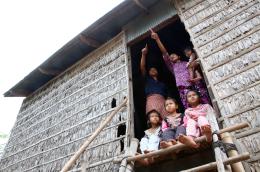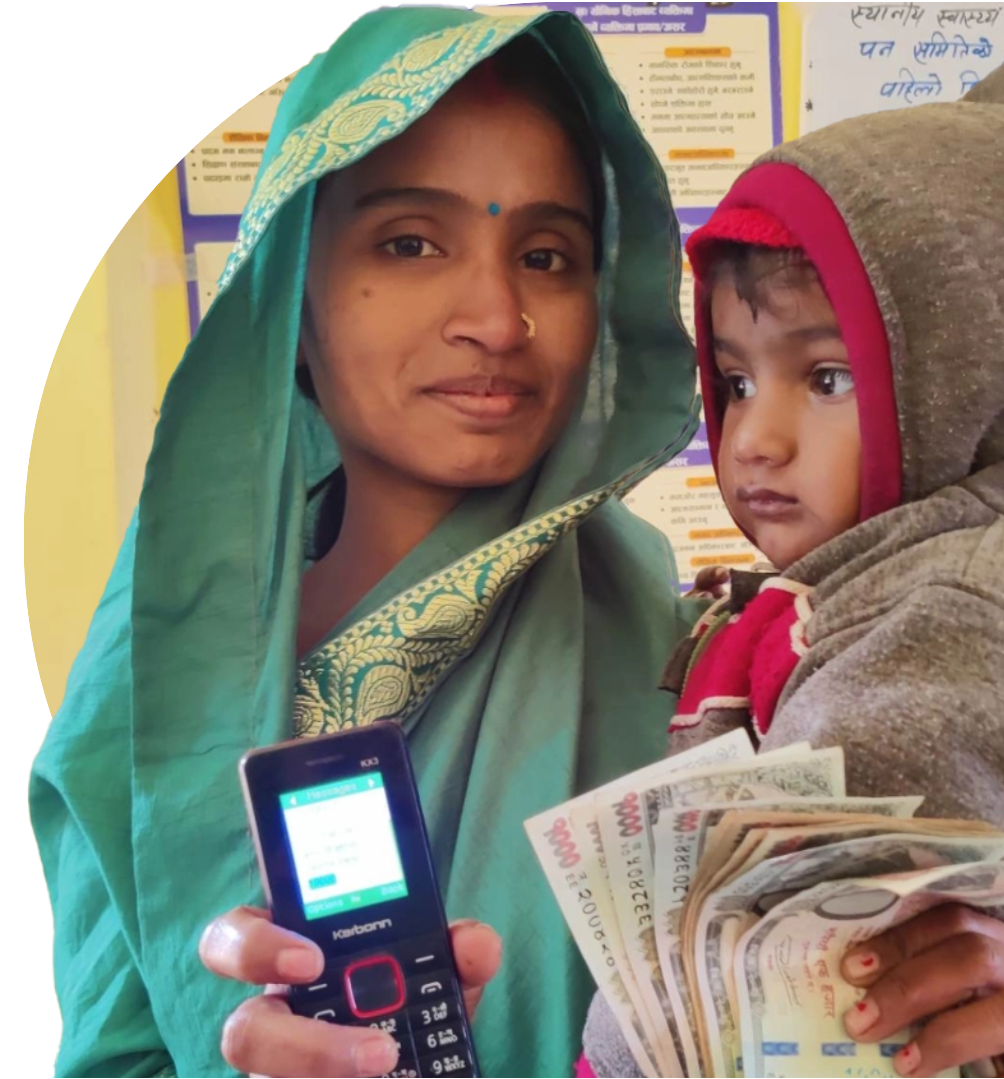How do we ensure that humanitarian cash transfers effectively reach the people most in need? Is blockchain a distraction or a value-adding technology for humanitarian response?
During a webinar held on April 29, 2024, UNICEF Nepal, together with the Office of Innovation, presented the findings from the evaluation of a blockchain-based cash transfer piloted in Nepal in 2023.
This was an excellent opportunity to explore how blockchain could augment emergency cash assistance and discover how innovative solutions can make humanitarian efforts more effective in reaching UNICEF’s beneficiaries.

Webinar Q&A
Were there any friction costs for the transaction processing?
If you refer to transaction costs, we used a permissioned blockchain for this implementation, which does not have a fee per transanction. So the cost would eventially be directly proportional to the OPEX of running the blockchain based platform + other associated services like SMS, IVR etc. Blockchains are considered costly (even permissioned blockchains). Our strategy is to use open source digital public goods in our implementations i.e. the cost of the code itself is saved.
—Arun Maharajan, Blockchain Technical Advisor, UNICEF Office of Innovation
Could you explain a little about the benefits of using blockchain vs a conventional digital voucher/ digital wallet/mobile money functions? We used push payments to digital cellphone wallets for COVID relief where any participant could receive value on any phone with USSD with zero friction costs.
Blockchains would improve transparency with ease of access for anyone. For e.g. in this specific pilot, if there was a requirement for the Central government of Nepal to look at transactions in real time, it is quite simple to do. Blockchains are dencentralised shared ledgers, which improves trust in the data - what this means is, while blockchains are known to disintermediate entities from the value chain, it is also of great benefit when there are multiple hops in the value chain. E.g. multiple FSPs, middle men, etc, by ensuring that everyone can potentially have a copy of the data and therefore the data is not in any one entities' control. This federates data in some sense and could be important in complex value chains where there are leakages.
—Arun Maharajan, Blockchain Technical Advisor, UNICEF Office of Innovation
The biggest advantage is real-time reconciliation data. The second is transparency as all the key stakeholders have access to the data.
—Usha Mishra, Social Policy Chief, UNICEF Nepal
Were there any recommendations about managing cross-border transactions where there might be multiple banking partners for settlement?
This pilot did not explore the cross border transaction usecase. In general, there are various blockchain based approaches to this, which UNICEF is exploring for any future pilots. In general, such approaches could make transaction and foreign exchange fees cheaper.
—Arun Maharajan, Blockchain Technical Advisor, UNICEF Office of Innovation
How do you guarantee that the use of blockchain technology is not adding to the GHG emissions challenge? Are you using a low emissions protocol, such as proof of stake?
Yes, this pilot used Hyperledger. If we use public blockchains, we have a very strong preference for Proof of Stake networks over Proof of Work.
This pilot used Enterprise Ethereum, which is a permissioned blockchain with very low energy consumption. If we use public blockchains, we have a strong preference for Proof of Stake networks over Proof of work networks if the other functionalities available are the same.
—Arun Maharajan, Blockchain Technical Advisor, UNICEF Office of Innovation
Are there any envisioned limitations on the scalability (number of users, speed of transactions)?
For this pilot, a permissioned blockchain was used. This is comparable to traditional cloud based apps in terms of scalability, users and speed of transactions.
—Arun Maharajan, Blockchain Technical Advisor, UNICEF Office of Innovation
Which blockchain are you using for this purpose and rationale behind choosing this particular blockchain?
We have used the EVM based chain for Rahat. for this pilot we used private EVM chains with proof of authority. Also, it helped with the regulation to conduct pilot in Nepal. but we are looking towards public chains, too.
—Manjik Shrestha, Blockchain Lead, Rumsan
How was the acceptability of digital payments? Is this something that was already embedded in the country's culture or was it necessary to build the culture?
There is no problem here (Nepal). Beneficiaries reported no problem and in fact (reported) high level of satisfaction.
—Usha Mishra, Social Policy Chief, UNICEF Nepal
Does the platform/system work offline? If yes, how did you deal with the duplicates when the platform used offline?
Yes, we enabled offline transactions for the vendors of our system.
To manage the duplicates, we generate the transaction hash with signature during the offline transactions, if someone tries to tamper while syncing the transaction when users goes online, transaction will get rejected if there are any duplicates.
—Manjik Shrestha, Blockchain Lead, Rumsan
Do you intend to go to public blockchain networks? What are the additional challenges for this?
In Nepal, crypto regulations do not allow us to use public blockchain networks. But Rahat can to go to public blockchain networks based on regulations in other countries and are exploring this.
— Rumee Singh, Co-Founder and CEO, Rumsan
UNICEF Ventures is exploring the use of digital assets on public blockchains for similar use cases in the future. The national regulations must allow this of course. We believe this can add further to the efficiency gains.
—Arun Maharajan, Blockchain Technical Advisor, UNICEF Office of Innovation
What are the types of internal policies that UNICEF introduced and/or expect to be introduced in the future to integrate block chain based transactions in corporate reporting and accountability?
UNICEF is prototyping this with the UNICEF Cryptofund, where we have been receiving and disbursing digital assets (ETH and BTC) for payments. Naturally, we posted all these transactions in the public domain with a block explorer link as proof.
—Arun Maharajan, Blockchain Technical Advisor, UNICEF Office of Innovation
Could you share about your efforts with the Government of Nepal or the Central Bank to use blockchain in its full capacity within the country's regulatory framework considering the Crypto ban in Nepal?
Blockchain can be used without crypto. This is just a shared accounting system that is digitally available to all those who haver access to the data/dashboard.
—Usha Mishra, Social Policy Chief, UNICEF Nepal
We have had conversations with the Government of Nepal and Central bank on building their awareness on blockchain. There have been some discussions and acceptance on CBDC - which will definitely be a big step. The crypto ban aspect still stays and is a separate issue.
—Rumee Singh, Co-Founder and CEO, Rumsan
Question for the country office: Are there any plans to scale up this initiative?
We are working with the government to replicate and scale up. Also plan to integrate this within our Anticipatory Action.
—Usha Mishra, Social Policy Chief, UNICEF Nepal
Can we use this technology in social protection systems?
Of course. This pilot was a great example of that. We can also extend blockchain technologies to address more nuances of social protection. (Addressed in more detail during verbal Q&A section.)
—Arun Maharajan, Blockchain Technical Advisor, UNICEF Office of Innovation
Can the system accommodate multiple financial service providers to play the role of intermediaries for cash disbursement to beneficiaries?
Yes, the system can accommodate multiple FSPs for cash disbursement.
—Hima Tamang, Project Coordinator, Rumsan
In the situation of forced migration due to political instability where it may be inappropriate for the government to host data of fleeing populations, who would be hosting the data?
For such use cases, we should consider using public blockchains (as long as digital assets are legal). For a roving migrant population, this would, in fact, be beneficial. The blockchain itself must not store any personally identifiable information (PII). There are also new developments in the public blockchain sphere about using zero-knowledge proofs and multiparty computation to truly maintain privacy while still using public infrastructure. This is an area of exploration for us. The PII data can be hosted by agencies who work with refugees or migrants and other agencies who intervene, as it already happens.
—Arun Maharajan, Blockchain Technical Advisor, UNICEF Office of Innovation
Stories by this author
UNICEF Venture Fund's Inaugural Climate Action Cohort Kicks Off in Stockholm
Read StoryRelated Stories

AGUA: Revolutionizing Global Collaboration for Funding Transparency (with Growth Graduate Atix Labs)





